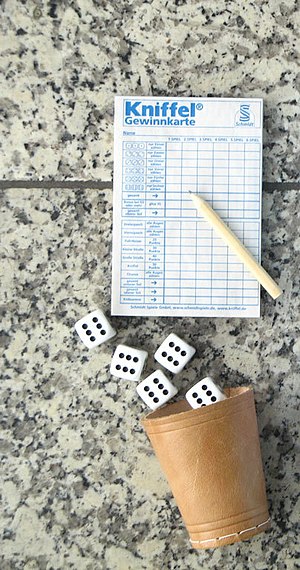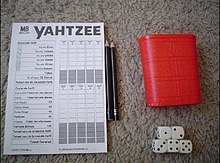Trick
| Kniffel / Yahtzee | |
|---|---|
 Trick accessories |
|
| Game data | |
| publishing company | ES Lowe (Yahtzee), Milton Bradley (Yahtzee), Schmidt Spiele (Kniffel), Hasbro (Yahtzee), VEB Berlinplast (Pasch) |
| Publishing year | 1956, 1973, 1984 (Yahtzee), 1972 (Kniffel), and others |
| Art | dice game |
| Teammates | 2 to 8 |
| Duration | 20-60 minutes |
| Age | from 8 years |
Kniffel or Yahtzee is a dice game with five dice , a dice cup and a special game block. The game is commercially available but is often played without the preprinted pad. It is derived from the Escalero , a South American form of dice poker , and the yacht , however, is much younger and with conventional playing dice played. Easily derived forms with slightly different rules are the Balut, popular in Denmark, as well as Yatzy , Yams or Kismet . There are also various variants and implementations, for example as a travel game or as a computer game.
history
The more original form, the Yahtzee, was brought to market by ES Lowe in the United States in 1956 . In 1973 ES Lowe was bought by the Milton Bradley Company (MB Games), by then 40 million Yahtzee games had been sold worldwide. Since Hasbro took over Milton Bradley again in 1984 , Yahtzee is now offered by Hasbro; According to Hasbro, 50 million Yahtzee games are currently sold annually. The Kniffel, launched by Schmidt Spiele in Germany in 1972 , hardly differs from the Yahtzee. Later other variants appeared with minor differences. Only minimally modified, the game was launched by Peri Spiele under the name Yam or Yams and in the United States as Yatzy . Here is different Yatzy of Yahtzee and Yahtzee is that the simple and the double as additional votes Pasch were taken. Yatzy is also played in Switzerland and partly in Austria. The Kismet version is also known in English-speaking countries . In the GDR , the game was produced by VEB Berlinplast and sold under the name Pasch until 1990 , including the single and double Pasch. In Denmark and parts of Southeast Asia, the basically similar balut is popular, but it differs significantly from Yahtzee in terms of its rating and emerged directly from a poker dice game.
New compared to its predecessors was a division of the blocks into an upper part with the pure number throws and a lower part with the so-called figures as well as the introduction of the "chance", in which any throw combinations can be added and entered. There was also the bonus in the upper block, which is awarded if the same number is thrown at least three times for all number rolls. The highest throw, five dice with the same number of dice, is called "Kniffel" or "Yahtzee".
Rules of the game
Each player receives a game pad on which he must enter his results. The winner is whoever can achieve the highest total on his slip in the end. The game is played with five dice and a cup and it is rolled in turn. In each round, each player can throw the dice up to three times in a row. You can put “matching” dice to one side and continue to roll with the remaining ones. After the second roll, dice that were retained on the first roll can be resumed. After the third throw at the latest, you have to decide on a free field on the game slip, which is now evaluated with the result of this throw - or delete a field.
Upper block
In the upper block ("inside" or collecting) the same dice values are recorded. If you get a total of at least 63 points (for example three dice for each field), you get a bonus of 35 points (jargon: you “get out”, “you are on target”).
Lower block
In the lower block (“outside”) figures are rolled and entered. If you enter a result in a field in which the condition is not met (for example, if three dice are not equal in the field of three of a kind), then the field is deleted or the number of points “0” is entered.
With the Kniffel, special points are provided for additional Kniffel throws. According to the official rules, 50 points are noted for each additional dice on the back of the game sheet, at the same time the sum of the dice is entered for the number throws in the upper area - a dice out of five twos then earns 10 points in the upper field + 50 points bonus .
With the Yahtzee there is a bonus of 100 points for an additional Yahtzee throw, which can be entered in the Yahtzee bonus field. If, however, a Yahtzee is thrown when the Yahtzee field is already filled with a 0, the Yahtzee score and bonus are omitted, the dice roll is noted as a normal number roll with five identical numbers as double, full house or chance.
Playing
If the game slip is full, the game is over and the points from collecting and the other games and possibly the bonus are added up. The player with the most points wins. A player can receive a maximum of 375 points in the regular game if he does not receive a bonus for additional Kniffel / Yahtzee.
Game block
The game block is the same in Yahtzee and Kniffel and consists of an upper and a lower block as well as columns for a total of six games. The following template is an example for two games.
| game | # 1 points | #2 points | #3 points | # 4 points | # 5 points | # 6 points | Remarks |
|---|---|---|---|---|---|---|---|
| One | - | 3 | Only one count | ||||
| two | 6th | 6th | Only two count | ||||
| three | 9 | 12 | Only threes count | ||||
| four | 12 | 8th | Only fours count | ||||
| Fives | 15th | 15th | Only fives count | ||||
| Six | 24 | 18th | Only sixes count | ||||
| Sum above | 66 | 62 | |||||
| bonus | 35 | - | 35 points if at least 63 points above | ||||
| Entire upper part | 101 | 62 | |||||
| Triple | 23 | 21st | Three equal numbers - all eyes count | ||||
| Foursome | - | 27 | Four equal numbers - all eyes count | ||||
| Full house | 25th | 25th | Three of the same and two of the same, different numbers - 25 points | ||||
| Small street | 30th | 30th | 1-2-3-4, 2-3-4-5, or 3-4-5-6 - 30 points | ||||
| Big street | 40 | - | 1-2-3-4-5 or 2-3-4-5-6 - 40 points | ||||
| Kniffel / Yahtzee | 50 | - | Five of the same number - 50 points | ||||
| chance | 21st | 19th | All eyes count | ||||
| Sum below | 189 | 122 | |||||
| Sum above | 101 | 62 | |||||
| Total | 290 | 184 | Above + Bonus + Below |
Strategic advice
Like all dice games, Kniffel and Yahtzee are games of chance and depend on the throws of other players. The game structure is very simple and can also be played well with young people. The decision as to which fields are to be filled in and the strategic assessment of the probability of getting certain dice pieces are more complex. At the end of the game, the number of options available decreases and the options are increasingly limited.
Common strategic tips are:
- First, the player should try to play the lower part of the block to avoid deletions. In the case of missed throws, the upper block can still be used.
- The bonus of 35 points in the upper block is very important and can be decisive for the game.
- A Kniffel / Yahtzee should not be thrown in every throw. It is important not to produce too many missed throws.
variants
In addition to the official rules, the game offers numerous possibilities to make the game more varied by changing the rules. Examples of this:
- Additional self-defined fields (e.g. two pairs, 2 times two pairs)
- Doubling of throws in one throw
- Predefined order of completion (e.g. from top to bottom or vice versa)
- Not three throws per person, but at least one dice with each throw - this must then be used for the overall result
- Filling in a column only in the 1st or 2nd throw
- Combinations of different rules with simultaneous play of several columns or over the whole sheet
- After the first throw you have to choose a variant, e.g. B. Kniffel or Full House etc., decide
- On the second roll, dice that have already been laid out can be used again and played with better ones
- Saving unused throws (e.g. if there is a usable knack on the first throw) for later rounds
In addition to these slight changes to the basic rules, there are also some variants that have the character of their own game. These include variants such as Center Up & Down , Lügenkniffel , Swiss Yahtzee and the Yatzy duel .
The Yams variant works with four columns, the first working like kniffle, the second and third must be filled in sequence, in the fourth a mandatory announcement is required after the 1st throw.
Another dice game is called Sachsenkniffel , but it is only based on Kniffel by name and is not related to it in terms of content.
literature
- "Yahtzee / Kniffel". In: Hugo Kastner: The great Humboldt encyclopedia of dice games. Humboldts Verlags GmbH, Baden-Baden 2007; Pp. 215-219. ISBN 978-3-89994-087-9
Web links
- Official rules of the game for Kniffel von Schmidt-Spiele (pdf; 2.9 MB)
- Kniffel in the game database BoardGameGeek (English)
- Yahtzee / Kniffel at the European Game Collectors Guild
- Probabilities and mean scores at the trick
- Mathematical consideration and calculation program for all game situations
Individual evidence
- ↑ Online version with description



